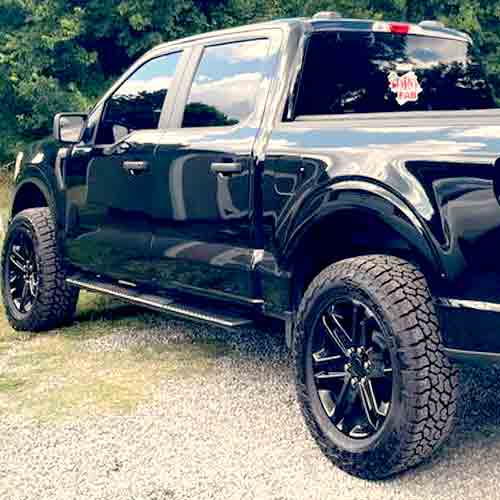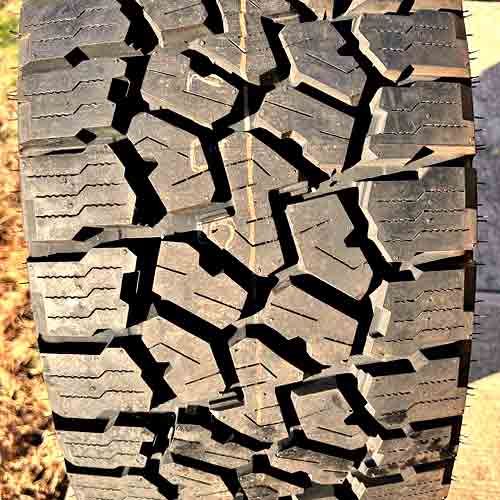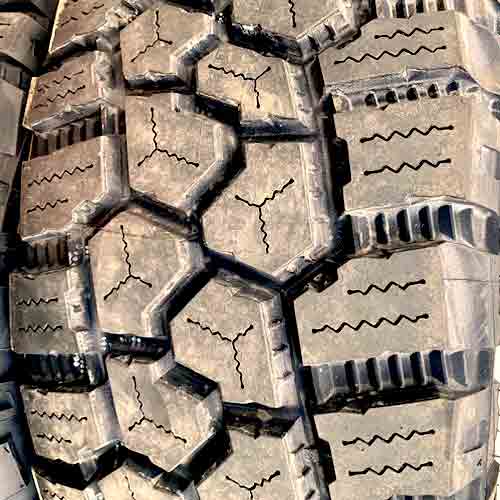Both the Cooper Rugged Trek and Falken Wildpeak AT3w, being all-terrain tires offer a satisfactory traction when it comes to mixed surfaces such as hard pack trails, light mud, sand and rocks, as they are not only bound to performing well on smooth roads.

In my expert opinion as a tire engineer, the Falken Wildpeak AT3w offers a superior traction when it comes to roads (in wet conditions especially). Though it’s also great off-road on rocks and sand. Cooper Discoverer Rugged Trek on the other hand, does better on mud, and if it haven’t been for it’s less durability, it would also have given an upper hand on rocky terrains.
Table of Contents
Tread Appearance
Both tires are pretty well designed, and they both have the new generation rubber composition.
Let’s start things off with Falken Wildpeak AT3w (from the middle).

In the central part of the tread, there are basically 3 main ribs, where the middle most has Z shaped blocks, while the surrounding have C shaped ones.
They are all equipped with a lot of different biters facing at various angles, so the tire is able to provide amazing off-road gripping. Though it does that without compromising on-road abilities.
That’s because the lugs in the middle are pretty closed up, so ample footprint is provided. And as these lugs have reinforced foundational supports (in the form of ridges), they don’t get to flex/bend a lot, and this gives amazing directional gripping values on highways.
Same is the case with shoulder lugs.
Despite having a lot of tread depth, they are restricted to bend/flex a lot as they are all pasted on a continuous running rubber layer underneath. So on-road traction is not compromised.
And at the same time with stepped edges and notches combined with staggered outer sides and sidewall lugs, the tire provides amazing lateral grip on all kinds of off-road trails, may it be rocks, sand or even mud.
Lastly, talking about sidewalls, the tire again offers a more rugged design featuring thicker lugs over there.
On the other side, the Cooper Discoverer Rugged Trek is also pretty unique. Let me start things off here with shoulders.

So the shoulder lugs are the most aggressive, stating the obvious.
These lugs basically are very well engineered, as they get to offer both on and off road abilities. Let me explain how.
Basically, off-road the tire’s sharp biters, staggered edges with mud scoops and sidewall lugs give grip on all types of terrains, and on highways, as these lugs are sitting on supports (foundations), which are seen as stone ejectors, they get to stay firm.
That means during cornering the lugs don’t flex/bend too much (which wastes energy), and so overall handling times are not compromised by a lot.
Similarly in the middle, as lugs are more packed up together inside the outer wider circumferential grooves, they get to provide ample contact patch to meet up with the road, enhancing directional grip.
And at the same time the various biters, provide off-road traction and the interconnected grooves these lugs make provide efficient self cleaning of the tread (which is highly need on dirt and mud filled terrains).
Internal Construction
The overall durability of a tire is judged by how many plies it has underneath the rubber.
Both tires have 2 ply polyester casings, with 2 belts on top, but the Cooper Rugged Trek has just a single cap ply of nylon, while the Falken Wildpeak AT3w gives you 4 cap plies, 2 on the middle section, and 2 covering the bead area.
So you get a more robust protection on Wildpeak, even though Rugged Trek has thicker sidewall lugs.
Sizes Facts
Let me put things in a tabular form here.
| Falken Wildpeak AT3w | Cooper Rugged Trek | |
| Total Sizes | 76 | 18 |
| Sizes Rims | 15 to 22 inches | 16 to 20 inches |
| Tread Depth | 12/32″ to 19/32″ | 16/32″ or 18.5/32″ |
| Weight Range | 35 lbs to 79.4 lbs | 40 lbs to 70 lbs |
| Speed Ratings | Q, R, S, T, and H | T and Q |
| Load Ratings | SL, XL, C, D, E, and F | SL, XL, E and F only. |
| Warranty | 55k miles on all | 55k on LT, 65k on non-LT |
| 3PMSF | Yes | Yes (but on limited sizes) |
Review Falken AT3w in detail: https://tiredriver.com/falken-wildpeak-at3w-review/
Pavement Performance
When conducting a dry performance evaluation of an all-terrain tire, it’s imperative to assess its traction, steering, and cornering characteristics. Let’s get into a technical analysis of these essential components for both of these tires.
Directional Grip
The calculation of dry grip or directional grip evaluates a tire’s traction performance on straight roads under dry conditions (and they get measure though braking distances and acceleration times assessments).
Note that, here the most important point to consider is how much a tire’s central tread meets up with the road (as this area holds maximum weight of the tire on it, making firm connection with the road).
That’s why it makes sense why Falken Wildpeak AT3w is doing better here in comparison.
This tire is more packed up in the middle, and despite having a lot of tread depth, as the lugs are reinforced with foundational ridges, you get to have a firm enough grip.
Cooper Discoverer Rugged Trek on the other hand, has a bulky design with lugs more spaced up apart. Moreover, these lugs also don’t have biters (facing in all directions, like seen on Wildpeak’s C shaped lugs).
Lateral Traction
Lateral traction comes in to play during cornering and it is contingent on the ground-outer shoulder lug bond. That’s because as the tire turns, the whole weight of vehicle gets shifted towards the shoulders.
That’s why with such wider grooves there, the Cooper Discoverer Rugged Trek suffers in comparison.
Falken Wildpeak AT3w has elongated lugs on sides. In fact, it’s shoulder blocks is covering the most of tread’s real estate, so it meets better with the ground during turning, providing greater lateral g forces and superior handling times.
Handling Feedback
The handling feedback simply tells how long a tire takes to respond to your steering inputs. And here the overall tire’s weight and structure come in to play.
And although it might surprise you a little bit, both tires show very similar capabilities here.
The Cooper Discoverer Rugged Trek although has a more aggressive pattern, the tire features smaller tread depth and is lighter in comparison. Both of these factors don’t create a lot of moving inertia on the lugs, and they get to respond quickly.
Falken Wildpeak AT3w on the other hand, although get to be heavier, also having a lot of tread depth, its closed up lugs arrangement still ensures, the steering response stay in line.
Wet Performance
A tire’s ability to remove water from the surface quickly is crucial for maintaining strong grip and avoiding hydroplaning on wet roads.
Let’s see how they affect the performance.
Wet Grip
The secret to a strong grip on wet roads lies in the combination of siping and flexibility. These two factors work together to effectively remove water from the tire tread, ensuring safer and gripping driving.
So it makes sense why the Cooper Discoverer Rugged Trek with less no. of sipes (even though having interlocking pattern), isn’t able to provide as much grip as the Wildpeak.
The Falken AT3w on the other side, not only comes with more number of sipes, but you also get dual design with the central ones providing directional traction and those on shoulder lugs offering the tire with lateral grip.
Hydroplaning
Hydroplaning happens when a tire is unable to clear water from its tread quickly enough and begins to float, leading to a loss of traction.
But with such wider/deeper grooves on both tires, it’s hardly going to be the case here. So you get to see good enough float speeds on both. Though as Wildpeak AT3w is a little faster, it still gets to perform better.
Fuel Efficiency
Usually, the heavier the tire gets, the harder it is to move, and so more fuel would get consumed but even though here Wildpeak AT3w has a heavier build, it’s still provides you with superior fuel economy why is that? Well let me explain.
The Falken AT3w basically has closed up lugs arrangement, and even though the tire is heavier, it’s weight get to divided on a larger surface area (of lugs).
Cooper Discoverer Rugged Trek on the other hand, with wider grooves, gets to put more pressure on each lug (as weight is divided on less no. of blocks).
Moreover, this tire also has unsupported lugs and they bend with turns, braking and acceleration, which wastes energy, and hence consumes more fuel as a result.
Tread Mileage
In the above section, I’ve explained why Falken Wildpeak AT3w has a high rolling resistance, and with it how it consumes more fuel and has a “faster wearing rate”. Though since tread depth is also a major contributing factor here, it does not mean, that the Cooper R-T would show you a better mileage.
In fact they are both equal here.
And that’s simply because, Falken AT3w has tread depth going up to 19/32″, so it takes some time to bring it down to 2/32″, which is the legal limit, (meaning its time to change the tires). You can check the tread of your tires with a penny, BTW.
For Your Info: The best tire for tread wear is General Grabber A/TX (explained), in all-terrain category.
Comfort
When it comes to overall ride comfort, there are two main key areas to note. One is the tread noise, and second has to do with bumps absorption.
And Falken AT3w is better in both.
Noise is just air particles hitting around, and the balder the tire is, the more they get to strike around generating noise. So here Wildpeak at3w with its compact design takes the upper hand.
Similarly, with it’s softer compound compared to Cooper Rugged Trek, it also soaks up the road imperfections in a better way, as well.
Also Read: Are all-terrain tires comfortable?
Winter Performance
On snow, all-terrains basically copy the tread features of winter tires by having a softer rubber, narrower section width and a lot of biters.
All of these basically help in one thing only, grabbing snow particles and lodging them in the grooves to make snow to snow contact.
And both tires here do a good enough job, and that’s why they get to have 3 Peak Mountain Snowflake (3PMSF) ratings as well. (What is 3PMSF rating?).
Both tires have a narrower design and provide you with a lot of biters. The Wildpeak AT3w has C shaped notches, and stepped edges on both shoulders and middle lugs, and they provide the “necessary” snow grabbing.
Whereas the Cooper Rugged Trek has powerful biters placed on the base of the shoulder grooves, and full depth interlocking sipes everywhere doing the same.
Also Read: Are all-terrain tires good in snow?
Traction Off Road
Some off-road terrains, like mud, can get very tough, as they require some very specialized features, while others like gravely road are much easier to navigate on.
Let me discuss all these terrains separately.
Sandy Dunes
On sand you need maximum floating and minimum digging, which is very bad for traction. That’s why you always lower the air pressure on this soft terrain.
Though because of other factors involvement, it makes perfect sense why Wildpeak AT3w provides a better efficacy overall (even though it’s a heavier tire).
Basically, this tire has wider shoulder lugs, which enhances the footprint with the sand upon lowering air pressure. And speaking of which, you can really go low on this tire as it comes with powerful rim locks.
Cooper Discoverer Rugged Trek on the other side, although features thicker lugs on sidewalls, they don’t give out as much contact patch to meet with the sand.
Recommended Read: Are all-terrain tires good on sand?
On Mud
Mud to mud contact loses friction, that’s why balded tires do better by cleaning off their tread effectively and quickly.
That’s why being a balder tire, the Cooper Rugged Trek shows better efficacy here. The tire has straight forward lateral and longitudinal grooves connected with each other. And all these tread voids have stone ejectors on the base. So mud leaves out easily and any dirt particles trying to settle in are ejected out.
Though Falken Wildpeak AT3w isn’t too far off either, as this tire has the advantage of greater tread depth. Moreover just like it’s competitor, it also has mud scoops on (serrated shoulder blocks), and thick enough sidewall lugs which provide further scooping.
Rocky Tracks
Cooper Discoverer Rugged Trek is a great tire to have for rocks, it does great with climb since its very light, and it’s powerful staggered shoulders and sidewall lugs provide amazing lateral traction.
Though there are a few key areas where it lacks too as well (unlike the other tire).
Like it does not provide you with enough biters in the middle like the Falken Wildpeak AT3w. Nor it has powerful enough sidewall lugs, where on Wildpeak you get 2 extra bead protecting layers of polyamide.
Takeaway
Cooper Rugged Trek may seem very tough on the outside, it’s inner construction is still weaker in comparison. That’s why off-road you’d get a more confidence aspiring ride with Wildpeak.
Though it does allow this tire to wear slower and be good enough in the fuel economy department.
Falken Wildpeak AT3w on the other side, is a faster tire on roads, providing more grip on both wet and dry conditions, as well as snowy roads. So, out of both, this one makes a better daily driver, if you ask me. Though the tire lacks on mud in comparison.